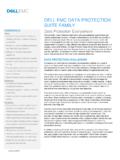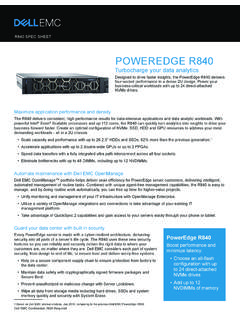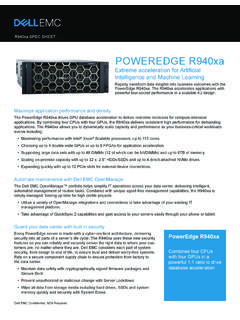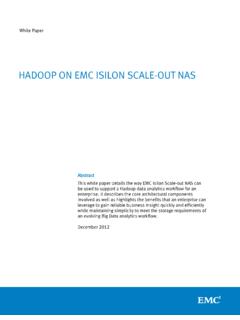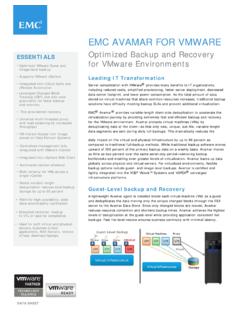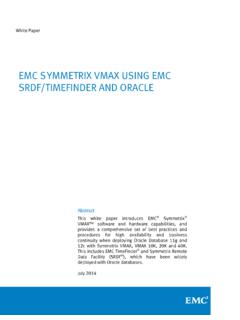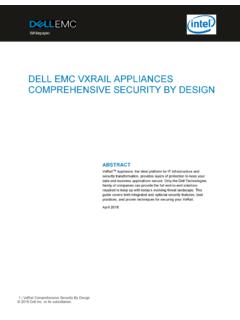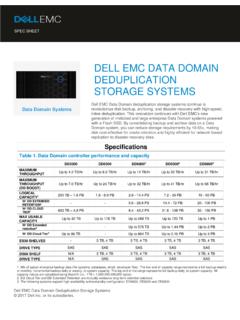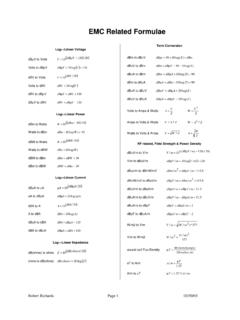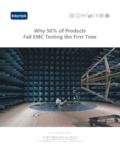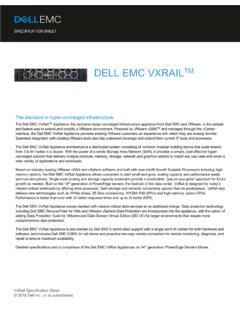Transcription of IDC I V I E W THE DIGITAL UNIVERSE IN 2020: Big Data ...
1 IDC 1414_v3 IDC I V I E W T H E D I G I T A L U N I V E R S E I N 2 0 2 0 : B i g D a t a, B i g g e r D i g i t a l S h a d o w s , a n d B i g g e s t G r o w t h i n t h e F a r E a s t December 2012 By John Gantz and David Reinsel Sponsored by EMC Corporation Content for this paper is excerpted directly from the IDC iView "Big Data, Bigger DIGITAL Shadows, and Biggest Growth in the Far East," December 2012, sponsored by EMC. The multimedia content can be viewed at Executive Summary: A UNIVERSE of Opportunities and Challenges Welcome to the " DIGITAL UNIVERSE " a measure of all the DIGITAL data created, replicated, and consumed in a single year. It's also a projection of the size of that UNIVERSE to the end of the decade. The DIGITAL UNIVERSE is made up of images and videos on mobile phones uploaded to YouTube, DIGITAL movies populating the pixels of our high-definition TVs, banking data swiped in an ATM, security footage at airports and major events such as the Olympic Games, subatomic collisions recorded by the Large Hadron Collider at CERN, transponders recording highway tolls, voice calls zipping through DIGITAL phone lines, and texting as a widespread means of communications.
2 With the rise of Big Data awareness and analytics technology, the DIGITAL UNIVERSE in 2012 has taken on the feel of a tangible geography a vast, barely charted place full of promise and danger. The DIGITAL UNIVERSE lives increasingly in a computing cloud, above terra firma of vast hardware datacenters linked to billions of distributed devices, all governed and defined by increasingly intelligent software. In this context, at the midpoint of a longitudinal study starting with data collected in 20051 and extending to 2020, our analysis shows a continuously expanding, increasingly complex, and ever more interesting DIGITAL UNIVERSE . This is IDC's sixth annual study of the DIGITAL UNIVERSE , and it's chock-full of new findings: From 2005 to 2020, the DIGITAL UNIVERSE will grow by a factor of 300, from 130 exabytes to 40,000 exabytes, or 40 trillion gigabytes (more than 5,200 gigabytes for every man, woman, and child in 2020).
3 From now until 2020, the DIGITAL UNIVERSE will about double every two years. The investment in spending on IT hardware, software, services, telecommunications and staff that could be considered the "infrastructure" of the DIGITAL UNIVERSE and telecommunications will grow by 40% between 2012 and 2020. As a result, the investment per gigabyte (GB) during that same period will drop from $ to $ Of course, investment in targeted areas like storage management, security, big data, and cloud computing will grow considerably faster. 1 The first DIGITAL UNIVERSE Study was published in 2007 (see ). At that time, IDC's forecast for the DIGITAL UNIVERSE in 2010 was 988 exabytes. Based on actuals, it was later revised to 1,227 exabytes.
4 2012 IDC 2 Between 2012 and 2020, emerging markets' share of the expanding DIGITAL UNIVERSE will grow from 36% to 62%. A majority of the information in the DIGITAL UNIVERSE , 68% in 2012, is created and consumed by consumers watching DIGITAL TV, interacting with social media, sending camera phone images and videos between devices and around the Internet, and so on. Yet enterprises have liability or responsibility for nearly 80% of the information in the DIGITAL UNIVERSE . They deal with issues of copyright, privacy, and compliance with regulations even when the data zipping through their networks and server farms is created and consumed by consumers. Only a tiny fraction of the DIGITAL UNIVERSE has been explored for analytic value. IDC estimates that by 2020, as much as 33% of the DIGITAL UNIVERSE will contain information that might be valuable if analyzed.
5 By 2020, nearly 40% of the information in the DIGITAL UNIVERSE will be "touched" by cloud computing providers meaning that a byte will be stored or processed in a cloud somewhere in its journey from originator to disposal. The proportion of data in the DIGITAL UNIVERSE that requires protection is growing faster than the DIGITAL UNIVERSE itself, from less than a third in 2010 to more than 40% in 2020. The amount of information individuals create themselves writing documents, taking pictures, downloading music, etc. is far less than the amount of information being created about them in the DIGITAL UNIVERSE . Much of the DIGITAL UNIVERSE is transient phone calls that are not recorded, DIGITAL TV images that are watched (or "consumed") that are not saved, packets temporarily stored in routers, DIGITAL surveillance images purged from memory when new images come in, and so on.
6 Unused storage bits installed throughout the DIGITAL UNIVERSE will grow by a factor of 8 between 2012 and 2020 but will still be less than a quarter of the total DIGITAL UNIVERSE in 2020. 3 F i g u r e 1 Source: IDC's DIGITAL UNIVERSE Study, sponsored by EMC, December 2012 Within these broad outlines of the DIGITAL UNIVERSE are some singularities worth noting. First, while the portion of the DIGITAL UNIVERSE holding potential analytic value is growing, only a tiny fraction of territory has been explored. IDC estimates that by 2020, as much as 33% of the DIGITAL UNIVERSE will contain information that might be valuable if analyzed, compared with 25% today. This untapped value could be found in patterns in social media usage, correlations in scientific data from discrete studies, medical information intersected with sociological data, faces in security footage, and so on.
7 However, even with a generous estimate, the amount of information in the DIGITAL UNIVERSE that is "tagged" accounts for only about 3% of the DIGITAL UNIVERSE in 2012, and that which is analyzed is half a percent of the DIGITAL UNIVERSE . Herein is the promise of "Big Data" technology the extraction of value from the large untapped pools of data in the DIGITAL UNIVERSE . 2012 IDC 4 F i g u r e 2 Source: IDC's DIGITAL UNIVERSE Study, sponsored by EMC, December 2012 Moreover, IDC believes that much of the DIGITAL UNIVERSE is unprotected. Our estimate is that about a third of the data in the DIGITAL UNIVERSE requires some type of protection to protect privacy, adhere to regulations, or prevent DIGITAL snooping or theft. However, currently, only about 20% of the DIGITAL UNIVERSE actually has these protections.
8 The level of protection varies by region, with much less protection in emerging markets. Therefore, like our own physical UNIVERSE , the DIGITAL UNIVERSE is rapidly expanding and incredibly diverse, with vast regions that are unexplored and some that are, frankly, scary. 5 F i g u r e 3 Source: IDC's DIGITAL UNIVERSE Study, sponsored by EMC, December 2012 However, the DIGITAL UNIVERSE astronauts among us the CIOs, data scientists, DIGITAL entrepreneurs already know the value that can be found in this ever-expanding collection of DIGITAL bits. Hence, there is excitement about Big Data technologies, automatic tagging algorithms, real-time analytics, social media data mining, and myriad new storage technologies. The Geography of the DIGITAL UNIVERSE Although the bits of the DIGITAL UNIVERSE may travel at Internet speeds around the globe, it is possible to assign a place of origin to them and chart the map of the DIGITAL UNIVERSE .
9 In this year's study, for the first time, we have managed to determine where the information in the DIGITAL UNIVERSE was either generated, first captured, or consumed. This geography of the DIGITAL UNIVERSE maps to the users of the devices or applications that pump bits into the DIGITAL UNIVERSE or pull bits into one's own personal DIGITAL solar system for the purpose of consuming information Internet users, DIGITAL TV watchers, structures hosting surveillance cameras, sensors on plant floors, and so on. 2012 IDC 6 F i g u r e 4 Source: IDC's DIGITAL UNIVERSE Study, sponsored by EMC, December 2012 In the early days, the DIGITAL UNIVERSE was a developed world phenomenon, with 48% of the DIGITAL UNIVERSE in 2005 springing forth from just the United States and Western Europe.
10 Emerging markets accounted for less than 20%. However, the share of the DIGITAL UNIVERSE attributable to emerging markets is up to 36% in 2012 and will be 62% by 2020. By then, China alone will generate 21% of the bit stream entering the DIGITAL UNIVERSE . 7 F i g u r e 5 Source: IDC's DIGITAL UNIVERSE Study, sponsored by EMC, December 2012 It stands to reason. Even though China accounts for only 11% of global GDP today, by 2020 it will account for 40% of the PCs, nearly 30% of smartphones, and nearly 30% of Internet users on the planet not to mention 20% of the world population. At the same time, the money invested by the regions in creating, managing, and storing their portions of the DIGITAL UNIVERSE will vary wildly in real dollar terms and as a cost per gigabyte. This disparity in investment per gigabyte represents to some extent differing economic conditions such as the cost of labor and to some extent a difference in the types of information created, replicated, or consumed.
